 
|
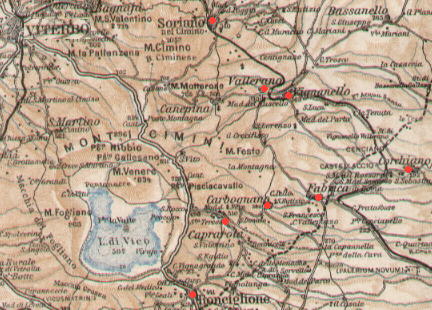 | ||
The eastern slopes of Monte Cimino descend towards the Tiber valley and have been inhabited since the time of the Etruscans; the little towns in this area are covered by this itinerary which starts from the south (Ronciglione) and goes north through Caprarola, Carbognano, Fabrica, Corchiano, Vignanello and Vallerano to reach Soriano sul Cimino. The tour of Monte Cimino can be completed by visiting the pages called In and about Viterbo.
Ronciglione
Ronciglione was ruled for centuries by the Anguillara family, although it formally belonged to the State of the Church. In the second half of the XVth century Ronciglione returned under the direct rule of the pope and Sixtus IV (1471-84) rebuilt the castle at the top of the medieval town. In the XVth century it was acquired by Cardinal Alessandro Farnese, who united Ronciglione to his other possessions north of Viterbo, which formed the Duchy of Castro. The rule of the Farnese lasted for more than a century until Innocentius X (1644-55) put an end to the Duchy of Castro.
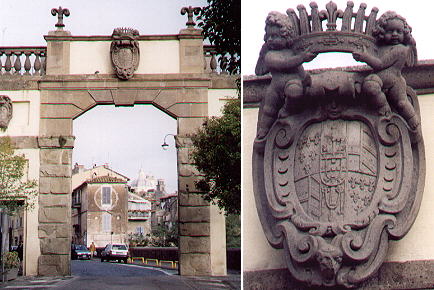 | ||
The Farnese built a grand entrance to Ronciglione. Porta Romana was designed by il Vignola and decorated with the Farnese heraldic lilies. It has been resized to accommodate a larger traffic flow. The elaborate coat of arms shows a ducal crown.
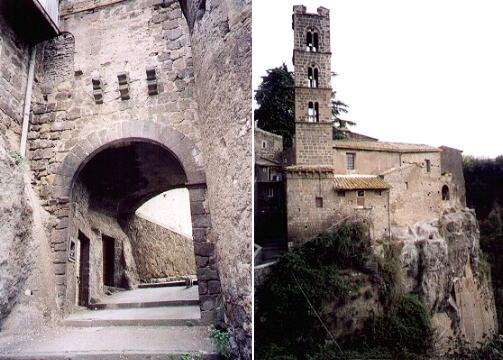 | ||
The medieval part of Ronciglione is built on a hill protected from three sides by a deep gorge. The image above shows the ancient entrance to the medieval town, which was built with stones and blocks of tufa. The tall bell tower of S. Maria della Provvidenza, next to the medieval gate, served also as a watching post for the early identification of enemies approaching the town.
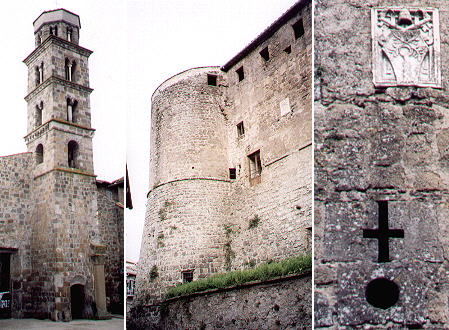 | ||
The bell tower of the lost church of S. Andrea is the finest monument of medieval Ronciglione which is dominated by the fortress built by Sixtus IV (for other images of the fortress, click here).
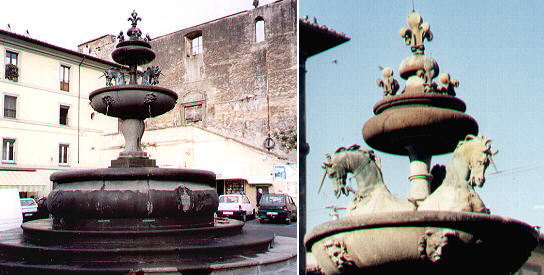 | ||
Il Vignola designed also the main fountain of Ronciglione. The unicorns are heraldic symbols of the Farnese, together with the more known lilies. The fortunes of the Farnese are usually attributed to Cardinal Alessandro Farnese who became pope in 1534 under the name of Paulus III; but the fortunes of Cardinal Farnese were mainly due to the influence of his sister Giulia, who was the last mistress of Pope Alexander VI (1492-1503) and convinced the pope to appoint his brother cardinal at the age of 25. Several Renaissance paintings showing a lady with an unicorn are thought to be portraits of beautiful Giulia Farnese.
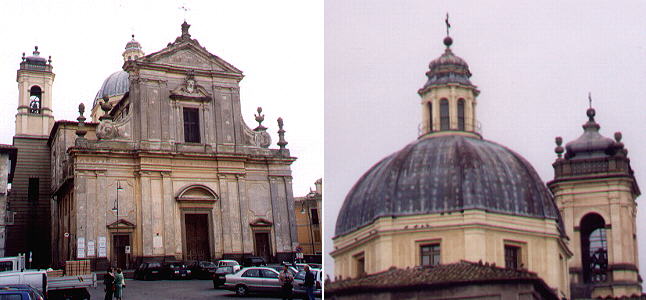 | ||
The cathedral (or il Duomo as the main church of a town is usually called in Italy) was designed by Carlo Rainaldi in 1660, although it was completed in the early XVIIIth century. The shape of the dome is similar to that of the domes designed by Rainaldi for the twin churches of Piazza del Popolo.
Around Monte Cimino - other pages:
Caprarola, Carbognano and Fabrica
Corchiano, Vignanello and Vallerano
Soriano al Cimino
some other walks:
Walks with Ferdinand Gregorovius in the Roman countryside
In and about Viterbo
A Pilgrims' Way
From Civitavecchia to Civita Castellana
From Bracciano to Viterbo
In Maremma
On the Edge of the Marsh
A walk to Porta Furba
Via Appia Antica from Cecilia Metella to Torre in Selci
Via Appia Antica from Torre in Selci to Frattocchie
Anticoli Corrado where the painters found their models
A Walk to Ponte di Nona
Branching off Via Cassia: S. Maria di Galeria, Isola Farnese and Formello
A Walk to Malborghetto
See my Home Page on Baroque Rome or my Home Page on Rome in the footsteps of an XVIIIth century traveller
All images © 1999 - 2003 by Roberto Piperno. Write to romapip@quipo.it
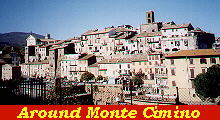 Ronciglione
Ronciglione